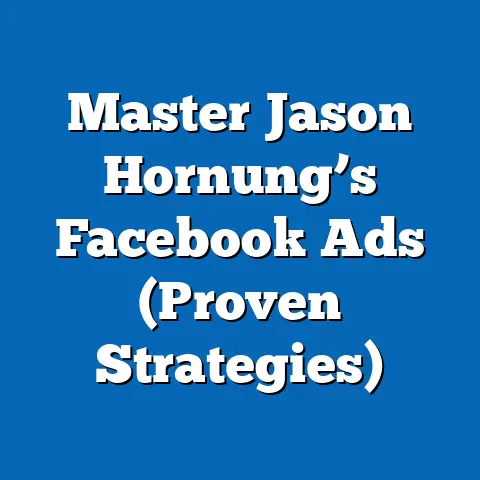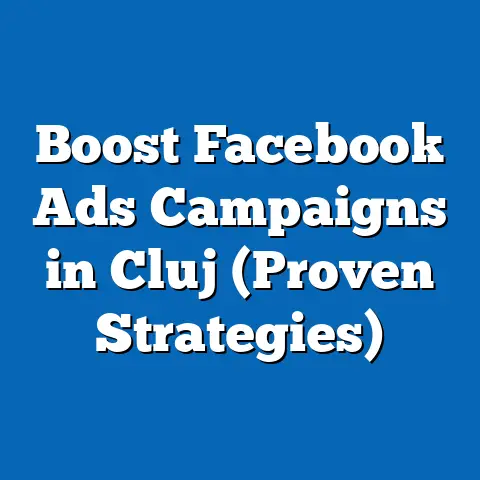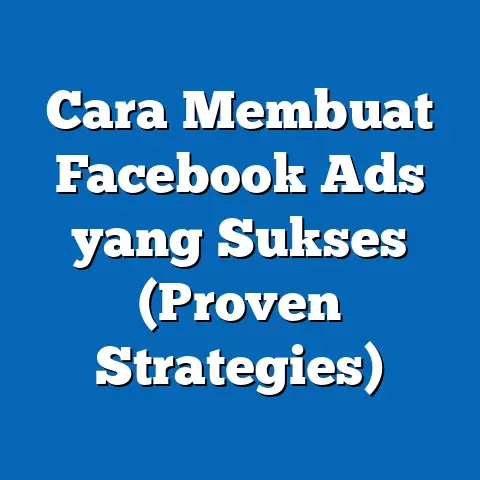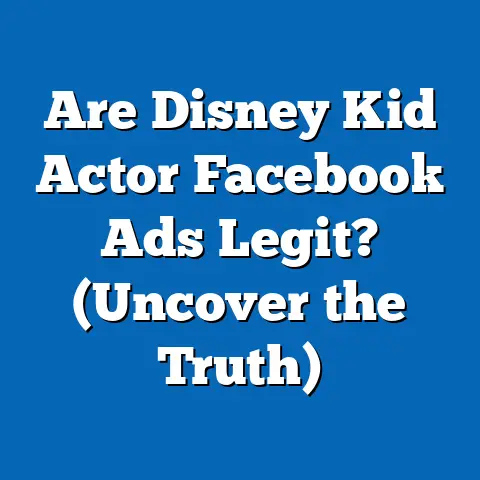Uncovering Facebook Ads Pitfalls (Expert Insights Inside)
In today’s fiercely competitive business arena, the relentless pursuit of growth often leads companies to explore various advertising avenues. Digital advertising has emerged as a cornerstone of modern marketing strategies, and within this realm, Facebook Ads stands tall as a powerful tool capable of reaching billions of potential customers. Yet, despite its immense potential, many businesses stumble when navigating the complexities of Facebook advertising, often falling prey to common pitfalls that can undermine their advertising efforts.
I’ve seen countless businesses, both big and small, launch Facebook ad campaigns with high hopes, only to be met with disappointing results. The truth is, a successful Facebook ad campaign requires more than just throwing money at the platform. It demands a deep understanding of the platform’s intricacies, a strategic approach to targeting, and a commitment to continuous optimization. This article is designed to be your guide through the minefield of Facebook advertising, providing expert insights into the most common mistakes and challenges that businesses face, and equipping you with the knowledge to avoid them.
Understanding the Landscape of Facebook Advertising
Facebook’s advertising platform is a behemoth, boasting an audience reach that spans across continents and demographics. With billions of active users, it offers unparalleled opportunities for businesses to connect with their target audiences. The platform’s sophisticated targeting capabilities allow advertisers to pinpoint their ideal customers based on factors like demographics, interests, behaviors, and even life events. This level of precision is a game-changer for marketers, enabling them to deliver highly relevant ads to the right people at the right time.
Facebook Ads plays a pivotal role in the current digital marketing ecosystem. It’s not just about reaching a large audience; it’s about reaching the right audience. I’ve seen businesses achieve remarkable results by leveraging Facebook’s targeting capabilities to connect with niche markets and build loyal customer bases. However, the platform is constantly evolving, with new features, algorithms, and best practices emerging regularly. Staying ahead of the curve is essential for maximizing the effectiveness of your Facebook ad campaigns.
One of the most significant trends in Facebook advertising is the growing emphasis on personalization and relevance. Users are becoming increasingly savvy to generic, irrelevant ads, and they’re more likely to tune them out. To succeed on Facebook, you need to create ads that genuinely resonate with your target audience, providing value and addressing their specific needs and pain points. This requires a deep understanding of your customer base and a commitment to crafting compelling, engaging ad content.
Common Pitfalls in Facebook Advertising
Facebook Ads can be a powerful tool, but it’s also a complex one. Many businesses, especially those new to the platform, fall into common traps that can lead to wasted ad spend and disappointing results. Let’s explore some of the most prevalent pitfalls and how to avoid them.
A. Misunderstanding Target Audiences
One of the biggest mistakes I see businesses make is failing to conduct thorough audience research. They often assume they know their target audience, but their assumptions are based on outdated information or incomplete data. This can lead to ads being shown to the wrong people, resulting in low engagement and wasted ad spend.
Facebook offers a wealth of targeting options, allowing you to narrow down your audience based on a wide range of factors. However, simply selecting a few demographic categories isn’t enough. You need to delve deeper into your audience’s interests, behaviors, and pain points. What are their hobbies? What websites do they visit? What problems are they trying to solve?
I once worked with a client who was selling a line of high-end skincare products. They initially targeted women aged 35-55, assuming that this was their primary customer base. However, after conducting thorough audience research using Facebook’s Audience Insights tool, we discovered that their actual customer base was much broader, including younger women in their late 20s and older women in their 60s. By expanding their targeting to include these additional segments, they saw a significant increase in ad performance.
Expert Insight: “Don’t rely on assumptions about your target audience. Use Facebook’s targeting options and Audience Insights tool to conduct thorough research and identify the most relevant segments for your ads.” – Sarah Jones, Digital Marketing Consultant
Takeaway: Invest time and effort in understanding your target audience. Use Facebook’s targeting options to reach the right people with the right message.
B. Ignoring Ad Quality and Creative
In the fast-paced world of social media, attention spans are short, and users are bombarded with content from all directions. To stand out from the crowd, your ads need to be visually appealing and compelling. Low-quality visuals, generic copy, and uninspired creative can lead to negative brand perception and reduced ROI.
I’ve seen countless ads that are poorly designed, with blurry images, cluttered layouts, and unreadable text. These ads not only fail to capture attention, but they also damage the brand’s reputation. On the other hand, I’ve also seen ads that are beautifully crafted, with stunning visuals, concise copy, and a clear call to action. These ads are much more likely to generate engagement and drive conversions.
Expert Insight: “Your ad creative is your first impression. Make it count by using high-quality visuals, compelling copy, and a clear call to action.” – David Lee, Creative Director
Takeaway: Invest in high-quality visuals and compelling copy. Create ads that are visually appealing, informative, and engaging.
C. Neglecting A/B Testing and Optimization
Facebook advertising is not a “set it and forget it” endeavor. It requires continuous monitoring, testing, and optimization. Many businesses make the mistake of launching a campaign and then simply letting it run, without making any adjustments based on performance data. This can lead to wasted ad spend and missed opportunities.
A/B testing involves creating multiple versions of your ads, each with slight variations, and then testing them against each other to see which performs best. This allows you to identify the most effective headlines, images, calls to action, and targeting options. I’ve seen businesses significantly improve their ad performance by simply running A/B tests and making adjustments based on the results.
Expert Insight: “A/B testing is essential for optimizing your Facebook ad campaigns. Continuously test different ad variations to identify what works best for your target audience.” – Emily Chen, Marketing Analyst
Takeaway: Embrace A/B testing and continuous optimization. Regularly test different ad variations and make adjustments based on performance data.
D. Inadequate Budget Management
Budget management is a critical aspect of Facebook advertising. Improper budget allocation can lead to campaign failure, while effective budget management can maximize your ROI. Many businesses make the mistake of setting unrealistic budgets or not understanding bidding strategies.
I’ve seen businesses set budgets that are far too low, resulting in their ads not being shown to enough people. On the other hand, I’ve also seen businesses set budgets that are too high, resulting in wasted ad spend. It’s important to strike a balance between reach and efficiency.
Understanding bidding strategies is also crucial. Facebook offers a variety of bidding options, including automatic bidding, cost per click (CPC) bidding, and cost per impression (CPM) bidding. Each bidding strategy has its own advantages and disadvantages, and the best strategy for you will depend on your specific goals and budget.
Expert Insight: “Effective budget management is essential for maximizing your ROI on Facebook Ads. Set realistic budgets and understand the different bidding strategies available to you.” – Michael Rodriguez, Financial Analyst
Takeaway: Develop a sound budget management strategy. Set realistic budgets and understand the different bidding options available to you.
E. Failing to Monitor and Analyze Performance
Tracking key performance indicators (KPIs) is essential for understanding the effectiveness of your Facebook ad campaigns. Many businesses make the mistake of not regularly reviewing ad performance, which can lead to missed opportunities and wasted ad spend.
Key KPIs to track include reach, impressions, clicks, click-through rate (CTR), cost per click (CPC), cost per conversion, and return on ad spend (ROAS). By monitoring these metrics, you can identify areas where your campaigns are performing well and areas where they need improvement.
I once worked with a client who was running a Facebook ad campaign to generate leads for their business. They were tracking reach, impressions, and clicks, but they weren’t tracking cost per conversion. As a result, they didn’t realize that they were spending a significant amount of money to generate each lead. By implementing conversion tracking and optimizing their campaign based on cost per conversion, they were able to significantly reduce their lead generation costs.
Expert Insight: “Regularly monitor and analyze your Facebook ad performance. Track key performance indicators (KPIs) to identify areas where your campaigns are performing well and areas where they need improvement.” – Jessica Brown, Data Scientist
Takeaway: Implement robust tracking and analytics. Regularly review your ad performance and make adjustments based on the data.
Case Studies of Facebook Ads Pitfalls
To illustrate the real-world impact of these pitfalls, let’s examine a few case studies of businesses that encountered major challenges in their Facebook advertising campaigns.
Case Study 1: The Misguided Targeting
A local restaurant launched a Facebook ad campaign to promote their new menu. They targeted a broad audience of “foodies” in their city, assuming that this would be an effective way to reach potential customers. However, their ads generated very little engagement, and they saw no increase in restaurant traffic.
Upon further investigation, it became clear that their targeting was too broad. While the term “foodie” encompasses a wide range of people, it doesn’t necessarily indicate an interest in the specific type of cuisine that the restaurant offered. By narrowing their targeting to people who had expressed an interest in similar restaurants or cuisines, they were able to significantly improve their ad performance.
Lesson Learned: Avoid broad targeting. Conduct thorough audience research and target specific segments that are most likely to be interested in your products or services.
Case Study 2: The Low-Quality Ad Creative
An e-commerce store launched a Facebook ad campaign to promote a sale on their website. However, their ads featured blurry images, cluttered layouts, and generic copy. As a result, their ads failed to capture attention, and they saw very few clicks or conversions.
By investing in high-quality visuals and compelling copy, they were able to create ads that were much more engaging and effective. They saw a significant increase in click-through rates and conversions, resulting in a much higher ROI.
Lesson Learned: Invest in high-quality ad creative. Use stunning visuals, concise copy, and a clear call to action to capture attention and drive engagement.
Conclusion
Facebook advertising offers immense potential for businesses to reach their target audiences and achieve their marketing goals. However, it’s essential to be aware of the common pitfalls that can undermine your advertising efforts. By understanding these pitfalls and implementing the strategies outlined in this article, you can significantly increase your chances of success on Facebook Ads.
Remember, Facebook advertising is not a “set it and forget it” endeavor. It requires continuous monitoring, testing, and optimization. By embracing a data-driven approach and staying up-to-date with the latest best practices, you can maximize your ROI and achieve your business objectives.
Now, take a moment to reflect on your own advertising strategies. Are you making any of these common mistakes? How can you apply the insights shared in this article to improve your Facebook ad campaigns? The time to act is now.






